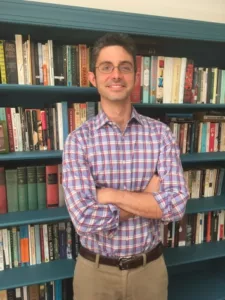Jeffrey Gonzalez

My article’s long backstory begins with a conversation I had while I was pursuing my Ph.D. at Penn State all the way back in late 2007. I met with Eric Hayot, whom I cite in the article, in advance of a seminar he would soon teach on globalization. I told him that I really knew very little about the contemporary picture of markets, exchanges, and financialization that we were all calling globalization back then, and I asked what I might need to learn before taking his course. I don’t recall the specifics of our conversation after that, but Eric ended it by suggesting that I read David Mitchell’s Cloud Atlas—which, I presume, he wanted me to see as a fictional work trying to interact with globalization in both content and form.
After this point, I spent significant time reading and thinking through how works like Cloud Atlas—say William Vollman’s Europe Central and Karen Tei Yamashita’s Tropic of Orange—were using similar representational strategies (crisscrossing narratives, temporal play, and wide geographical reach) to grapple with the post-1990 sense that the lived experience of time and space were changing. When I read Joseph O’Neill’s Netherland in Eric’s class that semester, it seemed incredibly distant from the sort of works I found so compelling, deeply unrelated to the new paradigm I wanted to explore.
Yet when I taught Netherland a few years later in a course on immigrant fiction—the narrator Hans is Dutch-born; he documents his five-year experience living in New York throughout the book—I was struck by how international O’Neill’s Manhattan is. In my second reading, rather than think about how little Netherland tries to replicate globalization in fictional form, I saw O’Neill opening up ways to see New York as a site where contemporary economic integration and paths of migration become plainly visible through how they inform many seemingly everyday interactions in the novel.
In that same year, Teju Cole’s Open City was released to rapturous praise. Many of the early conversations about the book focused on it as a 9/11 novel: in one oft-discussed scene occurring in increasingly nativist Brussels, Cole’s narrator Julius engages in a complex, inconclusive dialogue with two Islamic Moroccans migrants about September 11, 2001 and the U.S. response to it. I picked it up, thinking I might be able to use the book in a course on 9/11 fiction, and I was struck instead by the overwhelming similarities between Open City and Netherland. I begin my article with a list of the overlaps, so here I will simply state that each involve migrants to New York meeting lots of other migrants to New York while thinking of the other places they’ve lived and sometimes visiting still other locations across the globe (as in Julius’s interaction in Brussels).
The real hinge of my argument is that these texts do global-fictional work without taking the form of what are obviously more global fictions. I trace my ability to make this point to a combative question I got at the ACLA conference in 2008. I gave a paper on Mitchell’s narrative technique, which I called “seeing like a satellite,” based on the artificial intelligence who appears in the last sections of Mitchell’s 1999 Ghostwritten. My claim was that this benevolent figure and the sort of objective world-picture it could yield might be a useful way to think about the globalizing globe. An astute listener—I wish I had asked her name!—called me out: was I not talking about a transcendental signifier? Aren’t transcendental signifiers always situated, usually with privileged or dominant characteristics (whiteness, maleness)?
The satellite seemed to offer a neutrality or an objectivity so needed in the newly-networked world, and it always felt to me that this sort of objectivity was a key aim of the ambitious contemporary novel. Richard Powers regularly avers that fiction has the greatest value when it offers an “aerial view”: in Galatea 2.2 (1995), one of his characters questions whether fiction has any clear-cut value without this aerial/satellite perspective. What my questioner reminded—or perhaps revealed—to me was that someone has to see or report from the aerial view; someone would have to interpret the satellite imagery or program the satellite to tell stories—think of the biases that have manifested in AI algorithms and the ways they’d shape narratives.
Open City and Netherland address this complication within the genre of global fiction by situating their narrators as well-read, well-traveled, deeply flawed cosmopolitans. Here we see two texts that do recognize the limits of perspective even while they make the laudable attempt to understand and reflect the complexities of our current era. They depict migrants and migration in New York and other global cities not in a simple celebration of multiculturalism but because these cities are ever-changing texts whose composition and significance are inseparable from global economic flows, power imbalances and shifting hierarchies. Each book and each narrator become interesting not in spite of but because readers cannot get around the perspective of obviously subjective narrators who find so many rich ways to engage with these elements of contemporary life.
Writing about these two works has allowed me to explore the questions about fiction, temporality, globality, and representation that drew me to my Ph.D. in the first place, and I am grateful to the friends, audiences, and students who have helped me think the argument through.
